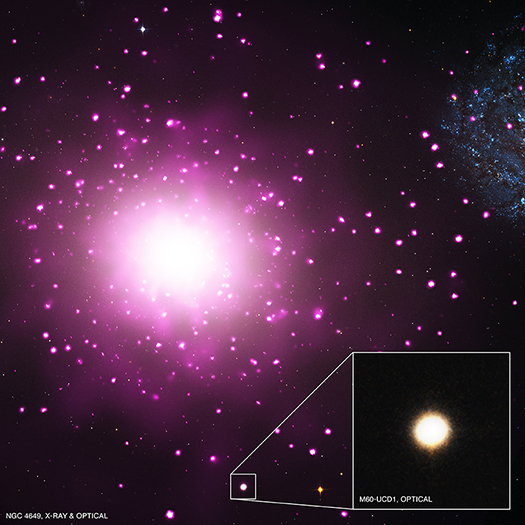NASA's Hubble and Chandra Find Evidence for Densest Nearby Galaxy
The densest galaxy in the nearby Universe may have been found, as described in our latest press release. The galaxy, known as M60-UCD1, is located near a massive elliptical galaxy NGC 4649, also called M60, about 54 million light years from Earth.
This composite image shows M60 and the region around it, where data from NASA's Chandra X-ray Observatory are pink and data from NASA's Hubble Space Telescope (HST) are red, green and blue. The Chandra image shows hot gas and double stars containing black holes and neutron stars and the HST image reveals stars in M60 and neighboring galaxies including M60-UCD1. The inset is a close-up view of M60-UCD1 in an HST image.
Packed with an extraordinary number of stars, M60-UCD1 is an "ultra-compact dwarf galaxy". It was discovered with NASA's Hubble Space Telescope and follow-up observations were done with NASA's Chandra X-ray Observatory and ground-based optical telescopes.
It is the most luminous known galaxy of its type and one of the most massive, weighing 200 million times more than our Sun, based on observations with the Keck 10-meter telescope in Hawaii. Remarkably, about half of this mass is found within a radius of only about 80 light years. This would make the density of stars about 15,000 times greater than found in Earth's neighborhood in the Milky Way, meaning that the stars are about 25 times closer.
The 6.5-meter Multiple Mirror Telescope in Arizona was used to study the amount of elements heavier than hydrogen and helium in stars in M60-UCD1. The values were found to be similar to our Sun.
Another intriguing aspect of M60-UCD1 is that the Chandra data reveal the presence of a bright X-ray source in its center. One explanation for this source is a giant black hole weighing in at some 10 million times the mass of the Sun.
More at http://chandra.harvard.edu/photo/2013/m60/
-Megan Watzke, CXC
Category:
- Log in to post comments

